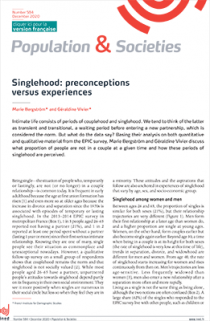Singlehood: preconceptions versus experiences
Press release Published on 07 December 2020
Population & Societies no. 584, December 2020

Authors: Marie Bergström and Géraldine Vivier
Intimate life consists of periods of couplehood and singlehood. We tend to think of the latter as transient and transitional, a waiting period before entering a new partnership, which is considered the norm. But what do the data say? Basing their analysis on both quantitative and qualitative material from the EPIC survey, Marie Bergström and Géraldine Vivier discuss what proportion of people are not in a couple at a given time and how these periods of singlehood are perceived.
Cross-analysis of the EPIC survey (Étude des parcours individuels et conjugaux, 2013–2014) and the qualitative follow-up survey on singlehood confirms that episodes of singlehood are now common and often occur more than once over the life course. It also sheds light on the different types of singlehood and the contrasting ways it is experienced by sex, social group, and age. In a society where the norm of being in a relationship remains strong, being single is accepted more easily when it is more frequent in one’s own social circle. This is the case for women, particularly clerical and manual workers, for whom it offers greater independence. Singlehood is perceived more negatively, however, when it deviates more markedly from the norm in an individual’s social environment. Singles in their thirties, an age where couplehood is predominant, stand out as a group whose experience of singlehood is particularly difficult and stigmatized.
Released on: 09/12/2020








